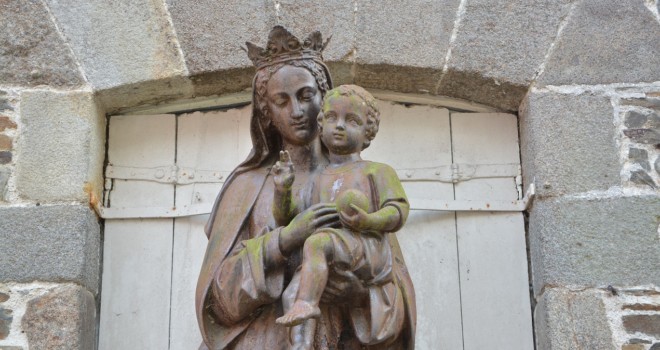“I am the Lady of the Rosary.” These are the words of the Blessed Virgin Mary when she revealed her identity to three children of Fatima, Portugal, in 1917. She taught them, “Pray, pray very much, and make sacrifices for sinners; for many souls go to hell, because there are none to sacrifice themselves and to pray for them.”
In
her apparitions, Our Lady was giving the three young visionaries personal
spiritual-warfare training and equipping them with a mighty weapon, the Rosary.
The Queen Mother herself commissioned these young ones into Christ’s mission
for the salvation of souls. By virtue of our Baptism, we too have been
commissioned into the same mission.
The visionaries at Fatima were nine-year-old Lúcia dos Santos and her cousins (brother and sister) eight-year-old Francisco and seven-year-old Jacinta Marto. These illiterate peasant children were heaven’s choice; the Mother of God came to them with messages for the entire world. Saint Paul famously wrote, “God chose the foolish of the world to shame the wise, and God chose the weak of the world to shame the strong” (1 Cor. 1:27).
The
soul-saving message of Fatima — to pray the Rosary, to make reparation for
sinners, and to promote the consecration to the Immaculate Heart of Mary — is
still relevant today, perhaps even more so. And Mother Mary did not spare the
truth when she trained her young warriors for battle. Rather, she showed them
hell, where poor sinners go:
We saw as it were a sea of fire. Plunged in this fire were demons and souls in human form, like transparent burning embers, all blackened or burnished bronze, floating about in the conflagration . . . amid shrieks and groans of pain and despair, which horrified us and made us tremble with fear.
Within three years of the apparitions, Mary had gathered up two of her little saints. Francisco and Jacinta died during an influenza epidemic. Both willingly suffered for the salvation of sinners, and both, knowing they would die young, sincerely looked forward to heaven.
In a vision to Jacinta, Mary offered to take her to heaven, but the little girl made a heroic sacrifice and chose to remain on earth a little longer in order to suffer to make reparation for sinners. Up to this point, little Jacinta had proved she could endure a variety of very difficult hardships. The worst for her, however, was yet to come. Loneliness was her greatest suffering, and at nine years old, she died alone in a hospital, far from her family and friends.
Sister
Lúcia was called to religious life and lived until she was ninety-seven. She
points to the Rosary as a weapon that the Virgin Mary has spiritually fortified
and strengthened for the needs of our times:
The Most Holy Virgin, in these last times in which we live, has given a new efficacy to the recitation of the rosary to such an extent that there is no problem, no matter how difficult it is, whether temporal or above all spiritual, in the personal life of each one of us, of our families . . . that cannot be solved by the rosary. There is no problem, I tell you, no matter how difficult it is, that we cannot resolve by the prayer of the holy rosary.
When praying and meditating on the mysteries of the Rosary, we accompany Mary and Jesus as they work out our salvation. We travel with them from the Incarnation through Jesus’ ministry all the way to the Cross. We experience the Resurrection on the first Easter morning and accompany the early Church up to the crowning of the Queen of Heaven. We see that the devil is crushed, and mankind’s worst enemy, death, is vanquished. The Rosary is a formidable spiritual weapon.
Like many holy men and women, Mother Teresa understood the power of the Rosary. When in an airport, travelers were asked if they carried any weapons. Mother Teresa complying with the request of the security officer held out her weapon: her rosary.
At the Heart of the Matter
Father Michael Gaitley writes, “The heart refers to one’s inner life and the seat of the indwelling Holy Spirit.” The heart is the essence of the person. It is at the core of our identity; it involves our thinking, our will, our love, and our decisions.
Through the Immaculate Heart of the Virgin Mary, souls
are rescued, graces procured, and the plans of the devil intercepted. Our
Blessed Mother explained this to the children of Fatima:
You have seen hell where the souls of poor sinners go. To save them, God wishes to establish in the world devotion to my Immaculate Heart. If what I say to you is done, many souls will be saved and there will be peace.
Jacinta’s devotion to the Immaculate Heart enabled her to love, to pray, and to offer sacrifices for the salvation of souls. This young visionary desired to put that same love and “fire,” as she labeled it, “into the hearts of all.” Her zeal — indeed her “fire” — are evidence of the Holy Spirit at work in her young heart. She told her cousin, “I so love the Immaculate Heart of Mary! If I could only put into the hearts of all, the fire that is burning within my own heart.”
The Virgin Mary holds the astounding events
of the plan of salvation in her humble heart: “Mary kept all these things,
pondering them in her heart” (see Luke 2:19). Her role in God’s rescue plan has
always been to bring Jesus to the world. From the very beginning, our Blessed
Mother was about her mission. “She went in haste” and brought the Savior,
hidden in her virginal womb, to the home of Elizabeth and Zechariah. The entire
plan of salvation involves the heart of Mary through her identity as Mother of
the Savior and Mother of the Church — of all of us.
Saint Teresa of Calcutta understood the spiritual power and significance of Mary’s heart and with childlike trust asked, “Mary, lend me your Immaculate Heart.” She also asked our Blessed Mother to take hers in exchange: “Keep me in your most pure heart.” Mother Teresa’s life, her ability to love beyond measure, was a gift to the world made possible through the Immaculate Heart of Mary.
We can do the same. It may sound oversimplified and even naive, but if we ask our Heavenly Mother, she will lend us her heart so we can come to love Jesus as we should. In turn, we ought to offer her our hearts, and she will remake them like hers. In this way, we can become single-hearted, “all in,” without duplicity. In other words, “pure of heart.”
Saint Louis de Montfort tells us that when the Holy Spirit finds his holy spouse, Mary, in a soul, He rushes to that soul to enter it in proportion to the place it has given to her. The Holy Spirit inhabited, and still does, Mother Teresa’s soul, her mission and her work, because He found Mary’s heart there.
If we want the Holy Spirit to inhabit us, to make our lives spiritually fruitful and triumphant against the enemy, we should follow Mother Teresa’s example and ask our Mother Mary to lend us her heart and to take ours in exchange. One of the most powerful ways to accomplish this is through Marian consecration.
Marian consecration means consecrating ourselves to Jesus through Mary. It is all about getting closer to Jesus and the easiest, fastest, most direct way we get there is through His Mother’s heart. Those who have done this, in the best sense, are never the same. Giving our hearts to Mary is life changing.
✠
This article is adapted from a chapter in Julie Onderko’s Holy Handmaids of the Lord: Women Saints Who Won the Battle for Souls. It is available from your favorite bookstore or online at Sophia Institute Press.














